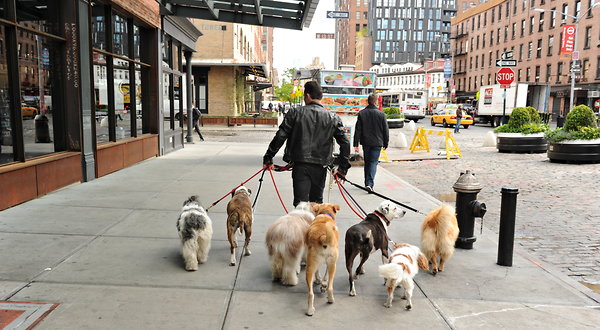CBS brings its version of dog whispering to prime time on Wednesday night with a series called“Dogs in the City,” which features a personable young man named Justin Silver, who has a keen sense of what is going on inside the canine head. There are other dog behaviorist shows, of course; this one’s gimmick is that all of its dogs are in New York City.
Do you have to be crazy to own a dog in a heavily paved, exceedingly crowded place like New York? Apparently not, because, Mr. Silver says, one out of eight New Yorkers owns a dog; that many people can’t be wrong. In the premiere Mr. Silver finds himself counseling a few who may not have lost their minds but have clearly lost their perspective.
For instance, a businesswoman named Elli insists on taking her dog, Charlotte, to work, even though the animal tries to attack anyone who walks through the door, and not in that friendly lick-your-face way. This is particularly problematic because “work” is some kind of talent agency, and models with dog bite scars are probably not all that marketable.
One of Mr. Silver’s most amusing tricks is to go off somewhere with the misbehaving dog and have a private chat.
“I know exactly what’s going on up there,” he tells Charlotte during their one-on-one. “You think I don’t know what it’s like to have a codependent mother?”
Charlotte genuinely looks as if she were taking it in.
The problem, naturally, is usually in the owner, not the animal.
“What I do is, I pay more attention to the people, and I’m watching the way the dog is reacting to what the person is telling me,” Mr. Silver explains while working another case, in which a man is giving his dog more attention than he gives his new wife. “So my job, I’m really more of an interpreter between the dog and the person.”
“Dogs in the City,” with its inherent reminder that it takes work to be a competent owner, serves as a useful counterpoint to “Shelter Me,” a film by Steven Latham that is showing on PBS stations in May and June (check local listings). “Shelter Me” is single-minded in its goal: It wants people to consider adopting a dog from a shelter.
Shelters, the program says, are overwhelmed with animals, especially now, when people are abandoning pets in a bad economy. Early on, Mr. Latham’s camera lingers on a blunt sign at a Los Angeles shelter: “Los Angeles Animal Services cannot guarantee placement of your animal. Animals turned into the shelter may be euthanized (killed) after the legal holding period.”
The American Society for the Prevention of Cruelty to Animals says that is the fate of three million to four million dogs and cats each year. “Shelter Me” aims for the heartstrings in trying to change the numbers, showing shelter dogs that have been trained to help people with disabilities, and others that are filling an emotional void for veterans with post-traumatic stress disorder.
“A lot of people think that dogs from a shelter are there because they’re bad dogs, because they’ve done something wrong, and that is a complete misconception,” Cassian Sandeberg, an animal behaviorist, says in the film. “A lot of these dogs are great dogs that people just can’t look after anymore.”
The film is so eager for people to adopt dogs that it doesn’t address its own contradiction: that shelters are jammed partly because not everyone can be a successful owner. A more nuanced approach is used in “One Nation Under Dog,” a riveting film showing June 18 on HBO.
This film also encourages dog adoption, but the first of several factoids it displays on the screen is this: “There are 4.7 million dog bite victims each year in the U.S.” That introduces an unsettling segment about a New Jersey dog owner who fought draining legal battles in defense of his dogs after they were involved in several biting incidents. In one, a girl’s ear was ripped off.
From this cautionary tale, the film grows even more stark, showing hard-to-watch footage of shelter dogs being thrown into large bins and gassed, then even harder-to-watch images from a raid on a wretched puppy mill in Tennessee.
“We found dogs living with dead dogs,” Scotlund Haisley, one of the animal rescuers at the scene, says. “One dog was using the two dead dogs as a blanket.”
The rescuers at the puppy mill, like the animal advocates in “Shelter Me,” seem somewhat overwhelmed by the cruelty they witness and the scope of the pet overpopulation problem. But it’s heartening to see them keep plugging away. A special prize should go to John Gagnon of the rescue group PAWS New England, who in “One Nation Under Dog” visits a shelter and specifically asks to look at the dogs with behavior and health problems.
The joy on these animals’ faces after he plucks them from the shelter, fixes what ails them and places them with new owners is undeniable and unrestrained.
“Once you bring a dog like that into your home and into your life, they appreciate it,” he says. “They know what they’ve got, because they’ve been without.”
.gif)




.jpg)


